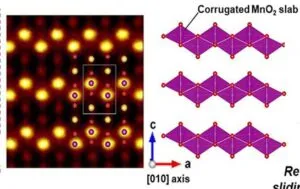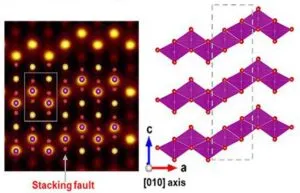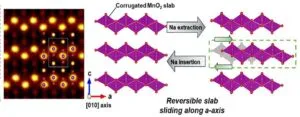The material is β-NaMnO2, a layered form of sodium manganese oxide, proposed as an electrode material for sodium ions to shuttle in and out of.

If it was well behaved, β-NaMnO2 would feature corrugated planes of MnO2 with sodium atoms sandwiched in between (diagram right).
Unfortunately the high temperatures typically needed to synthesise the material often lead to sodium deficiencies, according to the university.
 Attempts to correct these deficiencies instead cause sporadic slippage of the crystal’s b-c plane, creating something known as ‘stacking faults’ (diagram left).
Attempts to correct these deficiencies instead cause sporadic slippage of the crystal’s b-c plane, creating something known as ‘stacking faults’ (diagram left).
These don’t stay fixed, and instead get increasingly bad if β-NaMnO2 is used in a Na-ion battery.
“Electrodes made from stacking fault-containing β-NaMnO2 suffer from severe capacity reduction during charge-discharge cycles, limiting their practical applications,” said the university.
On top of this, these stacking faults have been holding up fundamental solid-state chemical research into this sodium manganese oxide as they foil certain analysis techniques.
A team lead by Professor Shinichi Komaba at the university had previously shown that replacing some of the manganese atoms with copper atoms can stabilise β-NaMnO2 through the slight size difference.
It then set out to see if copper doping could eliminate the stacking faults.
Results from this second project have just been published and show that copper doping can not only stop stacking faults forming in the first place, but it can keep them away through many charge cycles.
Komaba’s scientists systematically doped with different amounts of copper and, using synchrotron x-ray diffraction, showed that replacing 5% of Mn atoms were with Cu left a 4.4% stacking fault score, said the university, 12% copper dropped this to 0.3%, and 15% Cu meant ~0 stacking faults, “indicating a clear suppression of stacking faults with increased Cu doping”.
Evaluation in electrochemical half-cells showed rapid storage capacity loss within 30 charge-discharge cycles for un-doped β-NaMnO2, and no capacity loss over 150 cycles with 12% copper.
“These results suggest that the β-phase of layered NaMnO2 is inherently stable when stacking faults are eliminated,” said the university.
Without stacking faults to spoil analysis, the team was also able to delve into the solid-state chemistry for the first time, to find out what happens when sodium ions entered and leave the uncorrupted crystal.

X-ray diffraction, plus theoretical density function calculations, showed that the MnO2 layers can glide relative to one another as sodium ions enter and leave (diagram right), something that is inhibited by stacking faults.
“Our findings confirm that manganese-based oxides are a promising solution for developing durable Na-ion batteries,” said Komaba.
Findings have been published as ‘Synthesis and electrochemistry of stacking fault-free β-NaMnO2‘ in the journal Advanced Materials – which can be read in full without payment.
Image credit: Professor Shinichi Komaba, Tokyo University of Science
